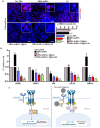Hybrid Biosilica Nanoparticles for in-vivo Targeted Inhibition of Colorectal Cancer Growth and Label-Free Imaging
- PMID: 39583322
- PMCID: PMC11585298
- DOI: 10.2147/IJN.S480168
Hybrid Biosilica Nanoparticles for in-vivo Targeted Inhibition of Colorectal Cancer Growth and Label-Free Imaging
Abstract
Background: Metastasis-initiating cells are key players in progression, resistance, and relapse of colorectal cancer (CRC), by leveraging the regulatory relationship between Transforming Growth Factor-beta (TGF-β) signaling and anti-L1 cell adhesion molecule (L1CAM).
Methods: This study introduces a novel strategy for CRC targeted therapy and imaging based on the use of a hybrid nanosystem made of gold nanoparticles-covered porous biosilica further modified with the (L1CAM) antibody.
Results: The nanosystem intracellularly delivers galunisertib (LY), a TGF-β inhibitor, aiming to inhibit epithelial-mesenchymal transition (EMT), a process pivotal for metastasis. Anti-L1CAM antibody-functionalized nanoparticles (NPs) target tumor-initiating cells expressing L1CAM, inhibiting cancer growth. The number of antibody molecules conjugated to the single NP is precisely quantified, revealing a high surface coverage that facilitates the tumor targeting. The therapeutic efficacy of the nanosystem is investigated in organoid-like cultures of CRC cells and in vivo mouse models, showing a significant reduction in tumor growth. The spatial distribution of NPs within CRC tumors from mice is investigated using a label-free optical approach based on Raman micro-spectroscopy.
Conclusion: This research highlights the multifunctional capabilities of engineered biosilica NPs, which offer new insights in targeted CRC therapy and imaging, improving patient outcomes and paving the way for personalized therapies.
Keywords: Raman imaging; antibody quantification; biosilica nanoparticle; colorectal cancer; in vivo treatment; targeted drug delivery.
© 2024 Delle Cave et al.
Conflict of interest statement
Chiara Tramontano is currently affiliated with Internal Medicine Department, Radboud University Medical Center, Radboud, The Netherlands. The authors report no conflict of interest in this work.
Figures








References
MeSH terms
Substances
LinkOut - more resources
Full Text Sources
Medical
Miscellaneous

